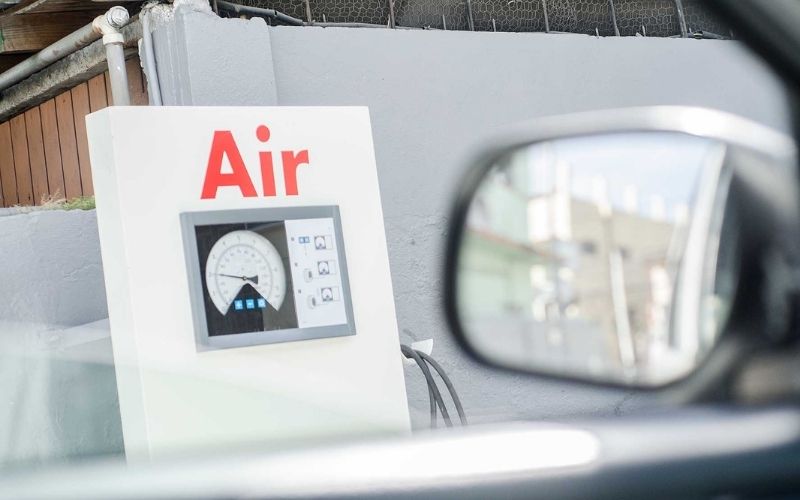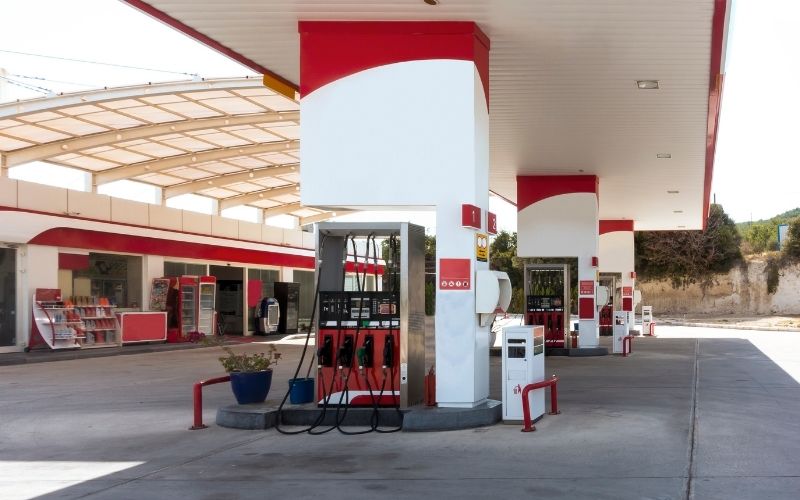Now you did it. A gas station with an air pump better is nearby. You can hear the noise. Crickity crick, crick…..ssssssssss.
You get out of your car and look at the rear tire. It is about as low on air as it can be without being flat.
There’s an intersection about a quarter of a mile ahead. You remember that there are two gas stations there.
But do they have air pumps? Don’t all gas stations have air pumps?
There’s no sense taking your car to put air in the tire when you just thought of a great idea for a research topic.
You’re going to need air in your boat trailer tires sooner or later. So let’s just leave the car right where it is, and do some research to find out if all gas stations do have air pumps.
Table of Contents
Do All Gas Stations Have Air Pumps?

The laws requiring gas stations to have air pumps vary by state. Some states require stations to have air pumps, some do not. Some require air to be free and some do not.
The most air pump-friendly state is perhaps California. There you find more stations that offer free air. Chevron, Shell, and Costco are the most likely gas stations to have air pumps.
But the best air is free air. A service called “Free Air Pump” lists gas stations that have free air. You can search for nearby stations. You just enter your address, city, state, or zip code, and search to find your answer.
The fun part is to use the Free Air Pump service to plan a trip. If you are going to head to the Atlantic or Pacific oceans, the Gulf of Mexico, or just a lake, you can know before you go where you can find air if you need it.
For example, there are eleven stations to get free air in the Miami, Florida area. Honolulu, Hawaii has eleven stations with free air. There are seventeen stations with free air in the Los Angeles area.
So get out those fishing rods, pick up some bait, and get some air in those trailer tires. The best part is knowing where to find air before you go.
Where Is The Air Pump At A Gas Station?
Years ago, you found service stations, not gas stations.
There you could not only have an attendant pump your gas, but he or she would also check under the hood to make sure your car had the proper amount of oil and water.
Because of this, air pumps were usually located near the gas pumps for the convenience of the attendant.
Of course, times have changed. With it, the air pump locations have changed, as well.
Today, you will typically find air hoses no longer come out of the ground. Now you can get air from a machine that is equipped with an adjustable meter. That way, you can adjust the amount of air your tires need.
It is safer to have the air pumps away from the gas pumps. You don’t want people bending over and pumping air while someone else is driving their car away.
Drivers turning their cars into the station from the highway may not see the air pumpers crouching down to put air in their tires. So modern-day stations usually separate their air pumps from the gas pumps.
Air pumps are often located at the extreme ends of the lot. For boaters, this provides an added convenience, as trailers have more room to be parked while you pump air.
Are Air Pumps At Gas Stations Free?

As mentioned, some gas stations offer free air pumps while some charge fees. But, most importantly, how does the cost of air affect the air gauge accuracy?
The National Center for Statistics and Analysis Research and Development, or NCSA , did a study to answer this question.
The NCSA found a relationship between the traffic volume at the gas station and the pump fees. The region of the United States where the pump was located also had an effect.
First, they looked at stations where few vehicles visited. Western state stations that charged fees for air were more likely to have a significant gauge inaccuracy than similar stations in other regions of the United States.
But in stations with a high number of vehicles visiting, the NCSA found that stations in the west were more likely to be accurate than other regions.
There was also a significant accuracy difference in free pumps versus pumps that have fees. Free pumps were found to be more accurate in all regions.
So, could it be that stations charging fees try to get customers to use more air, resulting in them spending more money at the air pumps? Or is this just a coincidence?
The NCSA stopped short of this conclusion. But they did remark that drivers should not assume that just because they are paying for air that the air gauge is more accurate.
So air at gas stations is not always free. But when it is free, the reading on the air pressure gauge may be more accurate.
Conclusion
Not all gas stations have air pumps for safety reasons. Those stations that do have air pumps tend to locate them away from gas pumps.
A site is available to find gas stations that offer free air. The air pump gauges at free air stations were found to be more accurate than those stations that charge for air.
Some stations no longer provide air pumps at all. Maintenance costs have caused some stations to hire companies to install and maintain air pumps.
The amount of revenue air pumps provide is minuscule when compared to the retail items stations offer. It is not worth it for stations to lose customers over air pump malfunctions.
But as a boater, it is worth it to keep those trailer tires filled and protect your investment.

I created this site to help people – to help you – with your boat problems. Instead of helping one person at a time, I want this website to be the “one-stop-shop” for everyone’s boating concerns. Read more.

